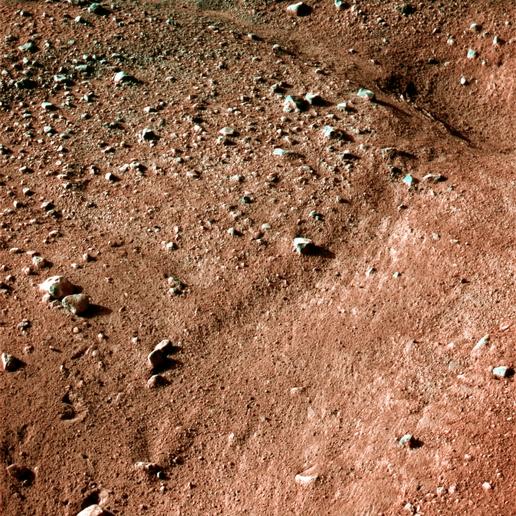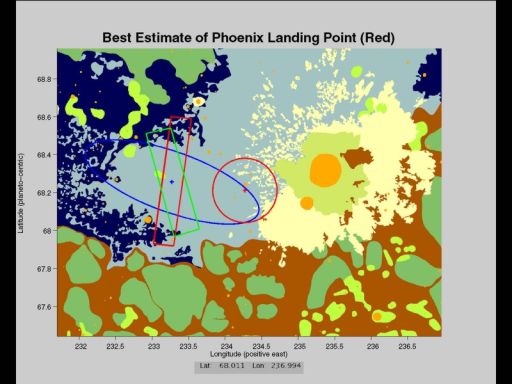Here are a couple of colorized images of Phoenix’s first views of its landing site. They are a little more exciting than the black and white version, and the human eye can pick out more detail in color. This is an approximate-color image taken shortly after landing by the Phoenix’s Surface Stereo Imager, generated from two color filters, a violet and an infrared filter. It shows the vast plains of the northern polar region of Mars. The flat landscape is strewn with tiny pebbles and shows polygonal cracking, a pattern seen widely in Martian high latitudes and also observed in permafrost terrains on Earth. The polygonal cracking is believed to have resulted from seasonal freezing and thawing of surface ice.
Phoenix touched down on the Red Planet at 7:53 EDT yesterday in an arctic region called Vastitas Borealis, at 68 degrees north latitude, 234 degrees east longitude.
Polygonal cracks are visible in this close up image of the Mars arctic tundra. This color version was again generated using one of the first black and white image sent by Phoenix and processed with two color filters. The SSI camera on Phoenix will be calibrated with colors on the spacecraft itself in order to make sure the color images it sends back will show the “real” colors on Mars as close as possible. SSI has a 12-position color filter that ranges from optical to infrared.
Phoenix’s approximate position on Mars is shown here. The red circle on the far right of the blue landing elipse is where the spacecraft is estimated to be. At the time this post is written, the Mars Reconnaissance Orbiter has probably already passed over this area on Mars and will attempt to image the lander on the surface of Mars. We’ll post that if the MRO team is successful in this difficult effort.
News Source: NASA




I’m really, really looking forward to seeing the true color image. In some of the current ones, there are areas, especially on the one rock at center left, which shows a greenish color. If that’s any rudimentary life – this is an historic day!!! Of course mere color is not enough, but it is very interesting. I hope UniverseToday.com can follow up on this.
Great PIctures. I wish you had a mission to Cydonia, I am almost sure the pictures will be more dramatic.
$420 Million bucks and the thing doesn’t have wheels!
That alone, is an amazing discovery! Only NASA could piss away that much money and provide a lander that can’t maneuver.
Congrats on the landing, but I am left wondering how much more a mobile lander would have cost?
Ballance, why do we need to? as peter said last night on the Nasa channel, the landforms under neath the lander are the same as the ones on the horizon.
sure, id like it to have wheels, but these guys know what they are doing.
@J. Tyler: very simple answers to an uninformed reactionary question:
1 Everything is more or less the same as far as you can see near the landing ellipse, so they are looking for representative soil / ice samples to analyze, which should be the same everywhere, therefore there is no need for mobility.
2 Spacecraft is weight / cost limited, thus even though mobility would be great (just in case, right…) the trade off benefit for the loss of mobility is extra science stuff! Eg, MER has no chemical analysis capability, but has mobility and Phoenix has capability for chemical analysis, but it is stuck in place
3 This is a lander not a rover by definition
NASA wouldn’t want to send a rover to the polar regions UNTIL they could determine for sure how far under the soil the ice was.
If they spent another 420 Million bucks for a rover and the rover sank into the crusty ice or uneven soil and got stuck, they would look pretty stupid don’t you think?
Feet to meters – meters to feet………..
I’m a little worried that they landed too far south of the the polar cap to get at the ice.
THAT would really suck!
good good Phoenix’s
i am irane
“””farsi”””
خداوند در Ùران از مخلوقات دیگر به غیر از انسان نیز یاد کرده.البته گویا Øتی نیت بد هم در باره زمین داشته اند Ú©Ù‡ به امر خدا وبا تیرهای اتشین از عمل انان جلوگیری شده است.من نمی دانم دین به این کاملی را چطور به غربی ها بد معرÙÛŒ کردن هر کدام از اØکام اسلام دارای Ø±ÙˆØ ÙˆÙلسÙÙ‡ خاص است سراسر قران از عظمت ودانش نوع بشر وبا تعبیر خلیÙÙ‡ الله نام برده.چرا شما نظام ما را Ú©Ù‡ بر اساس Ùطرت انسانها بنا شده نمی پسندید چند نمونه ازاخلاق وروش Øکومت ولایی بر اساس بینش تشیع برای شما Ù…ÛŒ گویم:ساده زیستی روش زندگی Øاکمان مانند مردم عادی پست وریاست هیچ مزیتی Ù…Øسوب نمی شود Ùقط مسئولیت ووظیÙÙ‡ است مردانگی وغیرت ببینید دنیا پرستی انسانها را نامرد Ù…ÛŒ کند هر کس نامرد بود بدانید دنیا طلب است.اصولا در اسلام این دنیا به منزله مزرعه است ÙˆØیات جاود وجاودانه مختص سرای دیگر است”farsi”
The images from Phoenix are tremendous! Now that they have been colourized they have improved no end! Colourised images like these will draw the general public’s attention.
A newspaper here in the UK published a number of images in colour this morning! They obviously expected their paper to sell like “hot cakes”!
Congratulations to everyone involved in the successful landing of Phoenix on Mars! 🙂